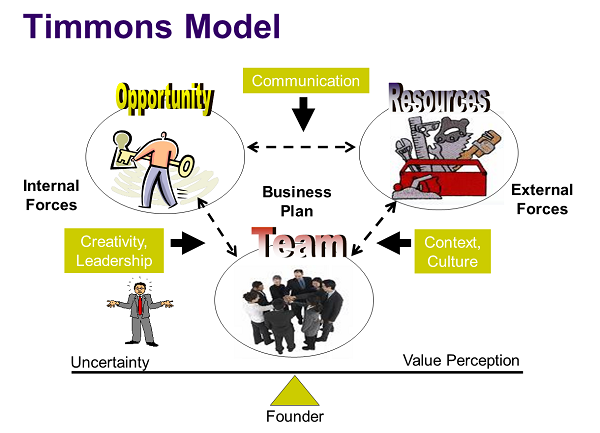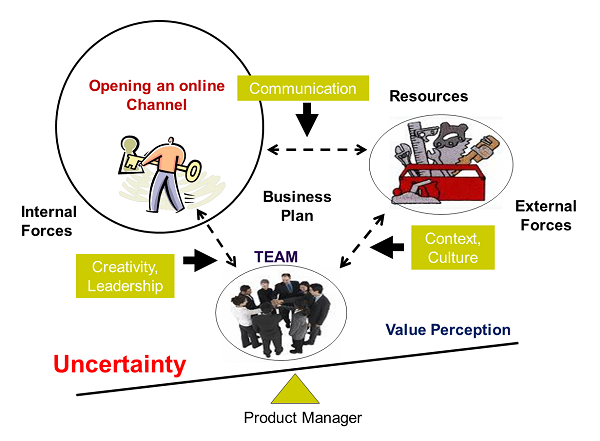NOTE: The following is a guest post by Veronica Figgarella. If you want to submit your own guest post, click here for more information.
An entrepreneurial approach to identifying an opportunity
As Product Managers we need to become experts in understanding the market our products are used and sold into, and smart about finding new customer problems to solve. An opportunity to solve a problem is often the first step in delivering a great product, but to deliver it we need resources, a team of people with varying domain knowledge, and a roadmap (or business plan) to manage uncertainty. We also need to deal with our own role/responsibility struggles as well as other external forces. It all sounds like building a new company!
An entrepreneur is often thought of as a person who left the corporate environment and into the risky world of “business on my own”. These individuals pursue a vision and transform it into action guided by their passion. They have to convince people to buy into their ideas, and often struggle with finding resources since the task at hand is usually bigger than initially expected.
Entrepreneurs are risk managers, and to cover their backs, they need to learn about the market they are in; the problems they are solving for their customers, and plan for adverse scenarios.
Similarities with Product Management are obvious! Product Managers ought to be entrepreneurial individuals just like business owners. We are both responsible for:
- Identifying the opportunity/problem
- Evaluating the opportunity/problem
- Finding solutions to the problem
- Finding the resources to develop the solution
- Managing a development process to deliver the solution
- Getting buy-in from people across the organization
- Measuring success and learning from the process
In today’s economic/social environment, it is critical that organizations develop and encourage an entrepreneurial and innovative culture so they adapt and learn to be resilient over time. If we think about our role, not only as employees but as corporate entrepreneurs, we may also rely on entrepreneurial theory to better understand the challenges we face.
The Timmons Model is an example of an easy-to-understand tool that might shed light into our daily struggle. Let’s look at its elements and relate them to our PM role.
In the Timmons model, the size of the opportunity will shape and determine the amount of resources and the team. In our case, the product manager acts as the founder and is the responsible for identifying the elements that will allow the model to be balanced. Moreover, in this dynamic context we need to ask ourselves: What can go wrong with this opportunity? What favourable events can happen? What risks can be eliminated? What are the minimum resources needed? … In essence we need to sort out the risk-reward equation to make the product sustainable.
At the heart of the model, there is the opportunity. As product managers who need to debate and present a business case, we need to become smart about calculating it. Quick questions for doing this are:
Is the customer reachable and how many are of them?
- What is customer payback?
- Is the market growing and at what rate?
- Is the market emerging or fragmented?
- What are the barriers to enter?
- What are we providing better than the competition?
- What are our margins?
- What are customer’s behaviours?
In entrepreneurship, resources follow a great opportunity and is a common misconception that they have to be in place in order to succeed. On the contrary, scarcity promotes innovation and just like in product management, what we are often short of is of great opportunities. We can learn from entrepreneurs to do more with less and practice focusing creativity.
The team is a key element in every new venture and is located at the bottom of the model. Whether a new company or product development communication and interpersonal skills will foster a better environment where creativity and support leads to a better working team.
An entrepreneurial product manager learns and teaches, deals with adversity and is resilient. She shows integrity and is dependable and honest and builds an entrepreneurial culture in the organization. The passion that drives the team will show as they are motivated, committed, are adaptable and are aware their locus of control is on the team and is not external. Empowered individuals are key to product management and product development.
Examples of how the Timmons Model works are abundant. Let’s say we work at a company whose core business is in retail and we are back in 1995 when the Internet was not as ubiquitous as today. As Product Managers we envision the day when our products are not only available to those who come to our store but to everyone who has a computer and internet access.
First question we have to ask is: how big is this opportunity? Then, do we have the resources and the team to open to online shopping? And of course is it the right time to develop this new business? In this scenario the Timmons model would look like this:
See how the opportunity is bigger than the resources as it would probably cost a lot of money to implement a new online channel back in 1995. Same happens with the team because it would have been hard to find people with the required experience to properly manage a new virtual store.
See also how uncertainty is bigger that the perceived value of the channel in the market posing a greater deal of risk and the need for a strong business plan to pursue this new project.
How would the model look if the same opportunity arose today? It would look balanced and straight forward (as shown in the first figure) because the context and culture have changed, Internet access is ubiquitous and the fears and discomfort of online shopping have diminished. Today very few products are not available online.
Also finding talented individuals to run a virtual channel is not a challenge anymore and implementing it is certainly cheaper than it was 15 years ago. This model also shows that opportunities are about timing and that if we want to go “over the fence” we need to keep our eyes and minds open to new ventures.
Understanding how the elements in the Timmons model interact and being aware of our role at balancing them will prevent our organizations from throwing too many resources at weak and poorly defined opportunities. So next time you feel like an acrobat at the circus trying to convey all variables to successfully manage a product, think of yourself as an entrepreneur and own your product as if you were its CEO. After all we all face the same challenges.
Veronica
– – – –
Veronica Figarella is a Product Manager and Marketing Specialist with more than 9 years of experience in the Telecom industry. She has worked in both Latin America and Australia. Veronica is based in Venezuela and works as a Small Business Consultant and teaches an undergraduate course on developing entrepreneurial skills. You can reach her on Twitter: @vfigatelix
Tweet this: Guest post by @vfigatelix – The Entrepreneurial Product Manager http://wp.me/pXBON-2Vh #prodmgmt #entrepreneurship

